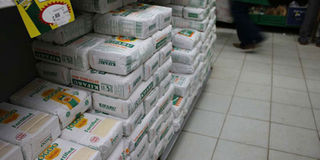Flour prices unlikely to come down until July, warn millers

Maize flour on sale in a shop. A two-kilogramme packet of flour is currently retailing at an average of Sh150, up from Sh90 last November. FILE PHOTO | NATION MEDIA GROUP
What you need to know:
- The CMA said the consignment of maize expected to land in Mombasa today is not sufficient to stop ongoing price inflation.
- Mr Masila said the drought that ravaged east and southern Africa in 2016 played a big role in plunging the country into the situation it faces.
Flour (unga) prices are unlikely to come down until July when the country is expected to have adequate stocks to meet its needs, millers said yesterday, setting up consumers for two and half more months of pain at the shop.
Industry lobby, the Cereal Millers Association (CMA), said in a statement that the steep rise in the staple’s prices is the result of a severe maize scarcity that is unlikely to be resolved until enough imported stocks land in the country – a process they expect to take one and a half months.
The CMA said the consignment of maize expected to land in Mombasa today is not sufficient to stop ongoing price inflation.
“Since in the initial weeks of the import programme some millers will have access to imported maize and others will not, the CMA does not expect maize flour prices to stabilise until adequate imported grain stocks are distributed across all the mills,” the statement said.
“This is expected to be in late June or early July. When this happens, prices are expected to settle at the Sh125 – Sh135 per two kilo packet range.”
PRICE INFLATION
A two-kilogramme packet of flour is currently retailing at an average of Sh150, up from Sh90 last November.
Millers reckon that most of them will continue to purchase maize at the prevailing high market rates until there is sufficient supplies.
“These prices (market price) are significantly higher than the cost of the recently released government maize,” the CMA said.
The first consignment of Mexican maize is expected to land in Kenya at a price of between Sh3,500 and Sh4,400 for a 90kg bag.
Pricing of the maize depends on volumes purchased and timing of the purchase, the millers said in a response to the food price inflation rage that has seen some commentators blame millers for artificially causing the price inflation by hoarding the maize.
EASING SHORTAGE
The millers said that the worsening scarcity of grains has continued to pile pressure on maize, which is now retailing at between Sh4,300 and Sh4,500 for a 90kg bag.
“Some millers are unable to produce enough maize flour to meet customer demand - they either do not have access to adequate grain and or are unable to compete with the prevailing market prices,” the statement said.
The millers said the inflow of Ethiopian maize, which was expected to ease the shortage, slowed down in the past week having brought to the market limited quantities that are priced at between Sh4,200 and Sh4,400 a bag.
Kenya is among the East African countries that signed a deal with Ethiopia to buy grains worth Sh5.5 billion, to help ease the acute shortage.
The deal allows Kenyan traders to import maize and pulses after signing 51 contracts amounting to 275,000 tonnes.
DROUGHT
According to Mr Gerald Masila, the director of East Africa Grain Council — the umbrella agency of cereal growers and millers — the drought that ravaged east and southern Africa in 2016 played a big role in plunging the country into the situation it faces.
The lobby also blamed poor storage that led it to reject 400,000 bags of maize that would have alleviated the situation.
“The National Cereals and Produce Board bought the little available maize, particularly from the North Rift, at relatively higher prices hence the resultant extra charges incurred by millers,” Mr Masila said.
He added that millers rejected maize from an earlier reserve because it was in poor condition.
Cereal Growers Association chief executive Anthony Kioko said processors rejected some of the maize in the grain reserve because it had overstayed in stores, leading to pest and aflatoxin infestation.
“We need about nine million bags of maize every year, but millers got only a small fraction of this from the last harvest,” Mr Kioko said.
SUBSIDISED
Mr Masila told Kenyans to brace for tougher times ahead “because while the government is working with other stakeholders to alleviate the situation, it will take a while for consumers to feel the effects”.
Importation of duty-free maize for milling, waiving of VAT on flour and releasing reserve by NCPB to millers are some of the interventions the government is implementing.
Kenya has traditionally relied on Tanzania, Malawi and Zambia for white non-genetically modified maize to bridge the shortfall, but the drought has also ravaged these countries.
The Strategic Grain Reserve stock, usually maintained by the NCPB to be used in instances of hunger has dwindling amounts.
Millers have also come under fire for failing to take subsidised government supplies which were aimed at lowering flour prices.
Dr Joel Ochieng, from the Kenya Universities Biotechnology Consortium says the country usually produces approximately 40million tonnes of maize against the production of 28million bags, leading to a deficit of 12million tonnes.
He encourages use of biotechnology in providing maize which is resistant to infestations, to avert losses. Dr Ochieng puts blame to the NCPB for the deteriorating condition of cereals when under their care and also agriculture extension services for not educating the farmers sufficiently on how to well preserve their grain produce.
NCPB Managing Director Newton Keter said they currently have 457,000 bags of maize, which is in good condition but not sufficient for the country’s consumption, hence the need to source more from imports.






